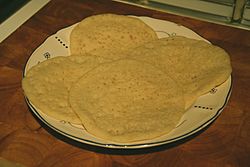Baghrir facts for kids
 |
|
| Type | Pancake |
|---|---|
| Region or state | Maghreb |
| Associated national cuisine | |
| Main ingredients | Semolina, often raisins |
Baghrir or beghrir, also known as ghrayef or mchahda, is a special kind of pancake. It is very popular in North African countries like Algeria, Morocco, and Tunisia. These pancakes are small and have a soft, spongy texture.
One of the most interesting things about baghrir is that when they are cooked correctly, they are covered in tiny holes. These holes are great because they help the pancake soak up whatever delicious sauce or topping it is served with.
Contents
What is Baghrir Made Of?
Baghrir pancakes are usually made from semolina or flour. Sometimes, people even add raisins to the batter for extra flavor.
How to Eat Baghrir
The most common way to enjoy baghrir in Algeria and Morocco is by dipping them into a mix of honey and butter. You can also cut them into pieces and serve them with jam.
Baghrir is a favorite for breakfast or as a snack. It is also very popular during Ramadan, especially for the evening meal called iftar. In Algeria, the Mozabite people have a tradition on the 9th day of Ramadan where they exchange baghrir with each other. They call this tradition "m'layin," and they also share these pancakes with people in need.
Where Does the Name Baghrir Come From?
In different parts of North Africa, this pancake has many names, like gh'rayf or kh'ringu. The word "baghrir" itself is mainly used in Morocco and Algeria.
Some people think the name "baghrir" might come from an old Arabic word that describes something that drinks a lot without getting enough. This makes sense because baghrir pancakes are like sponges; their tiny holes let them soak up a lot of sauce!
See also
 In Spanish: Beghrir para niños
In Spanish: Beghrir para niños

